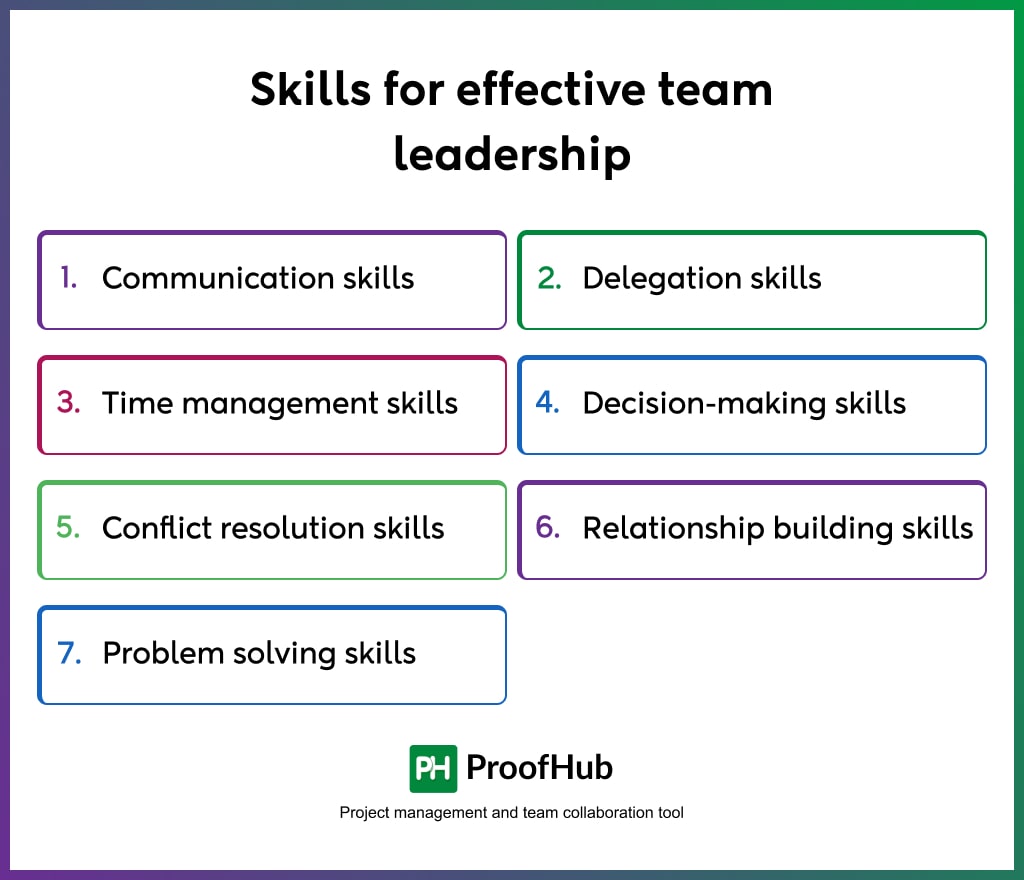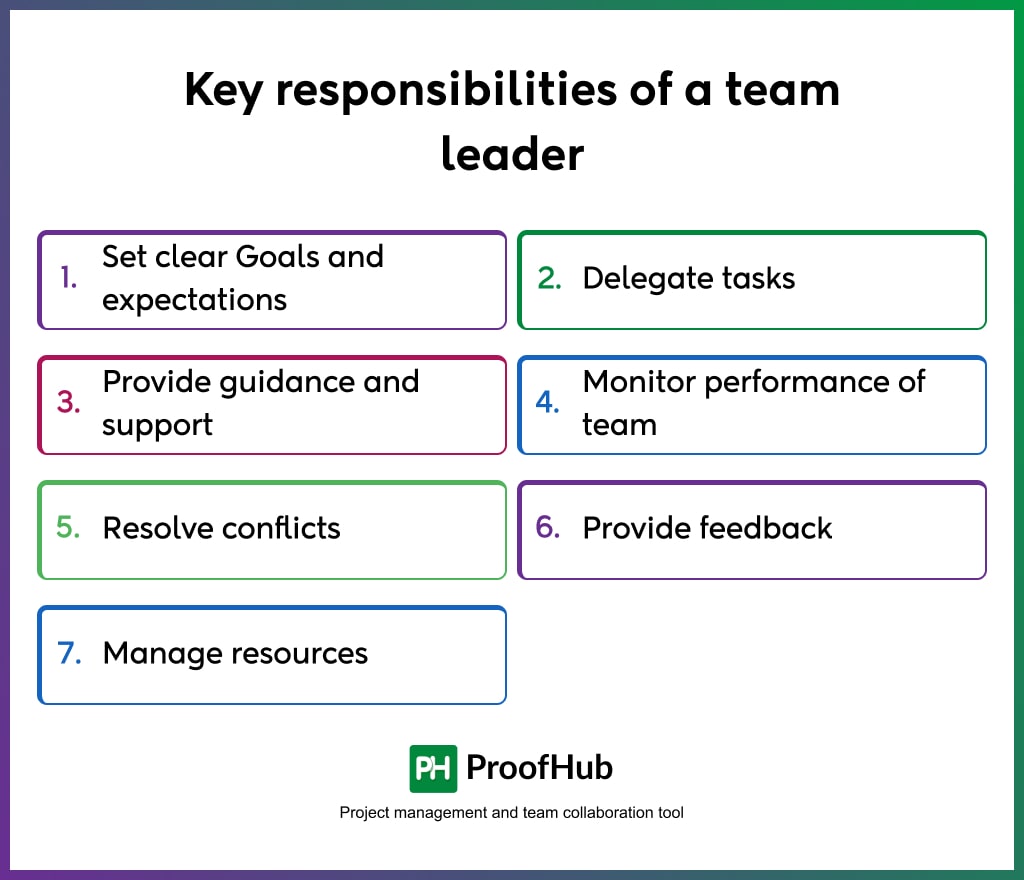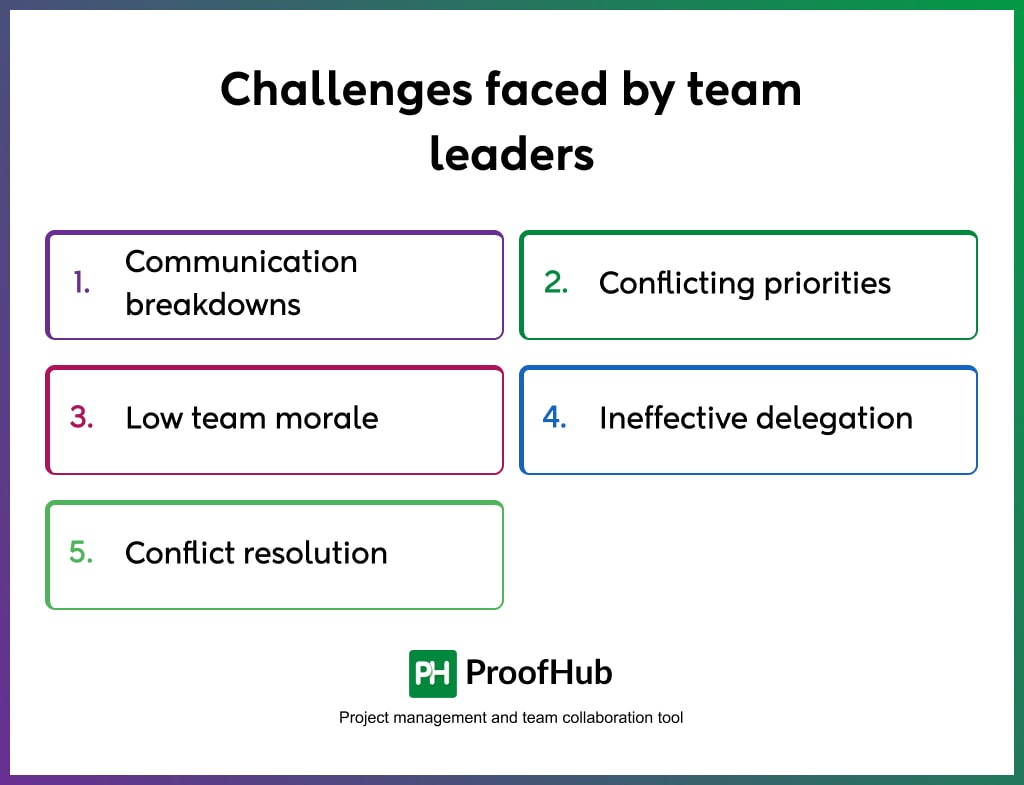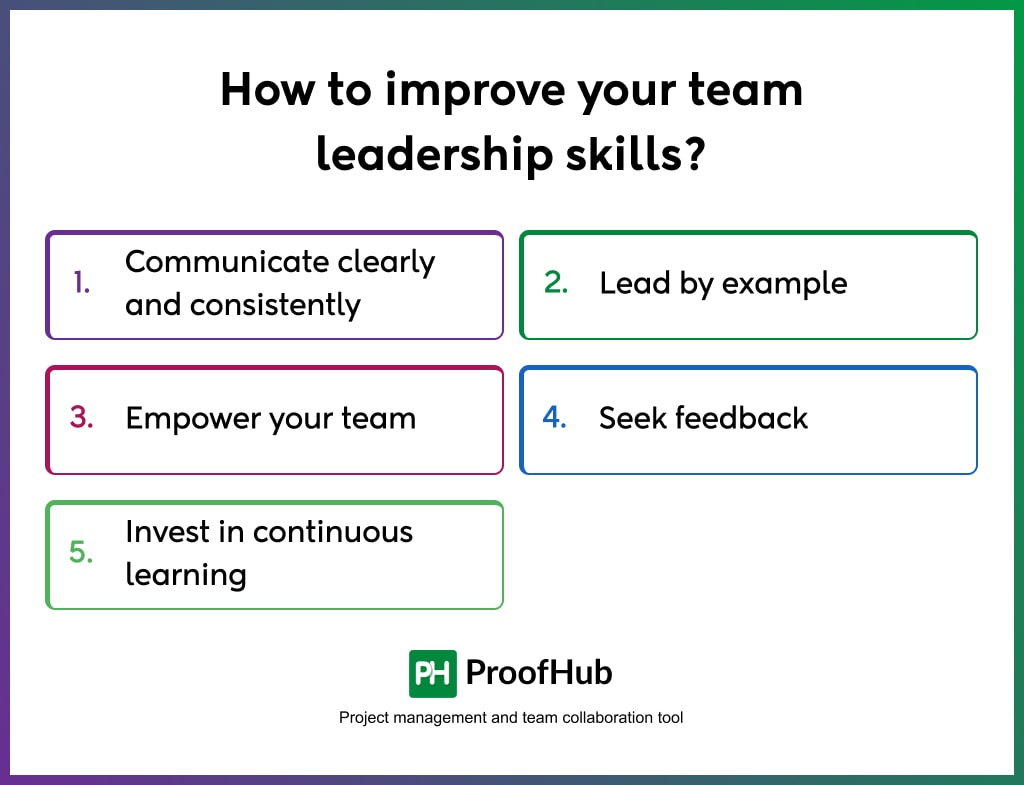Introduction
Under constant pressure to lead your team effectively?
If you are nodding your head, yes, you’re not alone. Many managers struggle to balance productivity, motivation, and cohesion while striving to inspire greatness.
The role of team leadership in modern workplaces is crucial yet often misunderstood. This comprehensive guide will unravel the essence of team leadership, covering everything from essential skills to popular models, and equip you with actionable insights to elevate your leadership game.
What is team leadership?
Team leadership is the process of guiding team members to achieve common goals, all while promoting trust and collaboration.
In contrast to traditional management, which frequently relies on top-down directives, team leadership focuses on inspiring and motivating each team member to contribute their best.
As a leader, you must always be present for your team members and provide support, encouragement, and assistance to ensure their success. Doing so lets you establish a connected and dynamic team prepared to confront any challenge.
Read more- Leadership vs management: What is the difference?
Why is team leadership important?
A prospering team is founded on the principles of effective team leadership. When you lead with a purpose, you establish an environment where all team members feel motivated, valued, and aligned with the team’s objectives. This fosters collaboration, enhances morale, and improves performance.
Empowering your team to achieve excellence is the essence of effective leadership; it is not merely about providing guidance. By comprehending and employing effective leadership strategies, you can substantially influence your team’s success and motivate them to achieve incredible feats.
Essential skills for effective team leadership
To be an effective team leader, you need essential skills to guide your team to success. These leadership skills are crucial for creating a thriving team environment where everyone feels valued and motivated.

Let’s break down these skills and why they’re so important.
1. Communication skills
Good communication is the backbone of any successful team. As a leader, it’s your job to ensure everyone is on the same page. Clear and effective communication prevents misunderstandings, keeps everyone aligned on goals, and builds trust within the team.
You can improve your communication skills by actively listening, being open to feedback, and communicating clearly and concisely. Practice empathy in your interactions, and aim to understand before being understood.
2. Delegation skills
You can’t do everything yourself, and that’s where delegation comes in. Effective delegation involves assigning the right tasks to the right people based on their strengths. This helps you manage your workload and empowers your team members to perform their best and within their comfort zone.
To improve your delegation, start by identifying your team members’ strengths, trusting them to handle tasks, and providing clear instructions and support as needed.
3. Time management skills
Time is a limited resource, and as a leader, how you manage it affects your entire team. Good time management helps you prioritize tasks, set realistic deadlines, and ensure that projects stay on track.
You can enhance your time management skills by using tools like to-do lists or project management software, setting clear goals, and learning to say no when necessary to avoid overcommitment.
4. Decision-making skills
Leaders frequently face tough decisions, and your ability to make the right call can make or break your team’s success. Effective decision-making involves gathering the necessary information, weighing the pros and cons, and confidently choosing a course of action.
To improve this skill, focus on staying informed, seeking input from your team, and learning from past decisions.
5. Conflict resolution skills
Conflicts are inevitable in any team, but as a leader, how you handle them can strengthen or weaken your team’s dynamics. Conflict resolution involves addressing disagreements calmly and finding solutions that satisfy everyone involved.
To develop this skill, practice active listening, remain neutral, and aim to mediate rather than dictate solutions.
6. Relationship building skills
Strong relationships are the foundation of a cohesive team. As a leader, you must build trust and rapport with your team members, fostering collaboration and a positive work environment.
You can strengthen your relationship-building skills by being approachable, showing genuine interest in your team members’ lives, and promoting a culture of respect and support.
Read more- Leadership skills you need to build a strong team
7. Problem-solving skills
Problems will arise, and your ability to tackle them head-on is critical to maintaining team morale and momentum. Effective problem-solving involves identifying the root cause of an issue, brainstorming solutions, and implementing the best course of action.
Sharpen your problem-solving skills by staying calm under pressure, encouraging creative thinking, and learning from each challenge.
Popular models of team leadership
When it comes to leading a team, there’s no one-size-fits-all approach. Different situations call for different leadership styles, and understanding a few key leadership models can give you the flexibility and insight you need to guide your team effectively. These models aren’t just theoretical—they’re practical tools that can help you navigate the complexities of team leadership.
Let’s dive into some of the most popular ones, breaking down what they are, why they’re helpful, how they work, and how they can elevate your leadership game.
1. McGregor’s XY Theory
McGregor’s XY Theory is a foundational model in management and leadership. It categorizes leadership styles based on two contrasting views of human nature: Theory X and Theory Y.
This model helps you understand your assumptions about your team members and how those assumptions influence your leadership style. Are you a Theory X leader who believes people need to be closely supervised or a Theory Y leader who trusts that people are naturally motivated and capable?
Theory X: Assumes that people inherently dislike work and need to be closely supervised or threatened with punishment to get the job done.
Theory Y: Believes that people find satisfaction in their work and will be self-directed when committed to their goals.
Recognizing where your assumptions lie allows you to adjust your approach to motivate and engage your team better. Embracing Theory Y, for example, encourages a more empowering and supportive leadership style, which can lead to higher morale and productivity.
2. Situational Leadership
Situational Leadership, developed by Hersey and Blanchard, is a flexible model that adapts your leadership style to the readiness and competence of your team members.
Not every team member needs the same level of guidance. This model allows you to tailor your leadership to fit the situation and the individual, providing the right direction and support.
Directing: High directive, low supportive behavior for those who need clear instructions.
Coaching: High directive and supportive for those needing guidance and encouragement.
Supporting: Low directive, high support for capable people who need confidence.
Delegating: Low directive, low support for competent and motivated people.
By adjusting your style to match the development level of your team members, you ensure they receive the appropriate support, which can boost their confidence, growth, and performance.
Read more- Adaptive leadership: challenges, principles and examples
3. The six emotional leadership styles
Daniel Goleman’s Six Emotional Leadership Styles model identifies six leadership styles based on emotional intelligence: Coercive, Authoritative, Affiliation, democratic, Pacesetting, and Coaching.
Different situations require different emotional approaches. By understanding these styles, you can lead in a way that resonates emotionally with your team, improving relationships and outcomes.
- Coercive: Demands immediate compliance, best used in crises.
- Authoritative: Inspires with a clear vision, great for driving change.
- Affiliative: Focuses on harmony and helps build morale.
- Democratic: Values team input, fosters collaboration, ideal for inclusive decision-making
- Pacesetting: Sets high standards, leads by example, and is effective with self-motivated teams.
- Coaching: Develops people for future growth, ideal for long-term growth.
By leveraging the right emotional leadership style, you can create a more cohesive and motivated team, leading to better performance and a more positive work environment.
4. Action Centered Leadership (ACL) or the ‘Three Circles Model’
Action-centered leadership (ACL), or the ‘Three Circles Model,’ was developed by John Adair. ACL focuses on three core responsibilities of a leader: Task, team, and individual.
This practical and straightforward model offers a balanced approach that ensures no aspect of leadership is neglected.
- Task: Achieving the task at hand by setting goals and planning.
- Team: Building and maintaining the team to ensure effective collaboration.
- Individual: Addressing individuals needs to keep everyone motivated and engaged.
Balancing these three areas ensures your team remains focused, motivated, and aligned with your leadership goals.
5. The Leadership Challenge
Based on the work of Kouzes and Posner, The Leadership Challenge outlines five critical practices for effective leadership: Model the Way, Inspire a Shared Vision, Challenge the Process, Enable Others to Act, and Encourage the Heart.
This comprehensive model addresses the actions and behaviors that make a leader effective and applies to leaders at all levels.
- Model the Way: Lead by example and demonstrate the values and behaviors you expect from your team.
- Inspire a Shared Vision: Rally your team around a common goal.
- Challenge the Process: Encourage innovation and be open to new ideas and approaches.
- Enable Others to Act: Empower your team through trust and collaboration.
- Encourage the Heart: Recognize and celebrate achievements to boost morale.
By following these practices, you can build a robust and resilient team that’s productive and deeply connected to their work and the goals they strive to achieve.
Key responsibilities of a team leader
As a team leader, your role is multifaceted, requiring you to wear many hats to keep your team on track and motivated.

Here’s a quick rundown of your key responsibilities:
- Set clear goals and expectations: Clearly define and communicate the objectives and expectations for the team to ensure everyone understands their roles and targets. This leads to alignment and focus, minimizing confusion and enhancing productivity.
- Delegate tasks: Assign tasks to team members based on each team member’s skills and strengths to maximize efficiency and productivity. Leveraging each team member’s unique talents helps maximize efficiency and productivity.
- Provide guidance and support: Provide continuous support and direction to team members, helping them overcome obstacles and achieve their goals. This facilitates personal and professional growth and ensures each member stays on track.
- Monitor team performance: Regularly assess team performance through metrics and feedback. This helps identify areas for improvement and ensure goals are being met.
- Resolve conflicts: Address and resolve conflicts among team members promptly and effectively. This helps to maintain a harmonious work environment and prevents issues from escalating.
- Provide feedback: Give constructive feedback regularly to help team members improve their performance and develop their skills. This facilitates growth and improves performance.
- Manage resources: Ensure the team has the necessary resources, tools, and support to complete their tasks efficiently. This prevents bottlenecks and supports smooth operations.
Common challenges faced by team leaders
Leading a team can feel like walking a tightrope, balancing various challenges while striving to keep everything on track. Let’s explore some common hurdles you might face as a team leader and strategies for tackling them effectively.

1. Communication breakdowns: Misunderstandings and a lack of clarity can derail progress. When communication falters, your team might miss deadlines or struggle with incomplete tasks.
Foster open communication channels and encourage regular feedback. Use communication tools like ProofHub to keep everyone informed and engaged.
2. Conflicting priorities: Balancing competing priorities can lead to confusion and frustration among team members. When priorities clash, productivity can drop.
Set clear goals and priorities. Use project management tools like ProofHub to align tasks with team objectives and track progress.
3. Low team morale: Low morale can impact team performance and increase turnover.
Recognize achievements, offer support, and create a positive work environment. Regular team-building activities and one-on-one check-ins can make a big difference.
4. Ineffective delegation: Poor delegation can overload and underutilize skills, often resulting in missed deadlines and burnout.
Identify each team member’s strengths and delegate tasks accordingly. Trust your team with responsibilities and provide guidance when needed.
5. Conflict resolution: Unresolved conflicts can create a toxic work environment and hinder teamwork.
Address conflicts promptly and fairly. Encourage open discussions and mediate disagreements to find mutually beneficial solutions.
Read more- What is conflict management and how to manage them in projects?
How to improve your team leadership skills?
Improving your team leadership skills is like polishing a gem – you want to ensure it shines correctly. Great team leaders are agile. They continuously hone their abilities to guide their teams more effectively.

Here are some tips and best practices to help you improve your leadership skills:
1. Communicate clearly and consistently: Effective communication is the essence of good leadership. Make sure you’re not just talking but also listening.
Regular check-ins, clear instructions, and open dialogue help build trust and ensure everyone is on the same page. To practice, hold regular team meetings and encourage feedback.
2. Lead by example: Your actions set the tone for your team. Demonstrate the work ethic, attitude, and values you expect from them.
If you show commitment and integrity, your team will follow suit. Model the behavior you want to see and recognize when your team mirrors them.
3. Empower your team: Delegate tasks and give your team the autonomy to make decisions. This helps them grow and shows that you trust their judgment.
To empower your team, clearly define their roles and responsibilities, then step back and let them take charge.
4. Seek feedback: Regularly ask for feedback on your leadership style. This can provide valuable insights into how you can improve.
Open and non-defensive communication creates a safe space for honest feedback. Use this feedback to adjust your approach and address any concerns.
5. Invest in continuous learning: Stay updated on leadership trends and techniques by attending workshops, reading books, and engaging in professional development opportunities.
Continuously learning keeps your skills sharp and helps you adapt to new challenges effectively.
Conclusion
In a nutshell, team leadership is essential for steering your team toward success. Strong leadership fosters collaboration, drives motivation, and efficiently meets goals.
If you’re looking to enhance your leadership skills and streamline your team’s workflow, ProofHub is a fantastic tool to consider. It offers powerful features to manage projects, collaborate seamlessly, and track progress – all in one place.
FAQs
What makes good team leadership?
Good team leadership involves clear guidance, strong communication, and empathy. It’s also about building trust, motivating your team, and effectively handling conflicts to achieve shared goals.
What are the four traits of successful leadership?
Successful leaders share four key traits: vision, empathy, resilience, and decisiveness. Cultivating these qualities will help you inspire trust, guide your team more effectively, and drive collective success.
What are the strengths of a team leader?
As a team leader, your strengths include inspiring others, providing clear guidance, and fostering teamwork. Embrace these qualities to motivate your team, drive success, and create a positive work environment.

